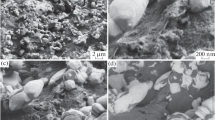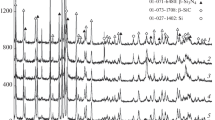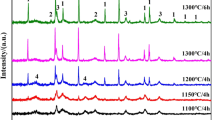Abstract
The oxidation behaviour of two types of SiC powder of differing particle size and morphology distribution has been studied in the present work; one submicron-sized and the other micron-sized. It has been observed that the onset-temperature for significant oxidation of the SiC powder of smaller particle size is much lower than that for the SiC powder of larger particle size; namely, about 760 °C as compared with about 950 °C. Furthermore, the rate and extent of oxidation of the former SiC powder is much higher than that of the latter SiC powder. Interestingly, however, the SiC powder of smaller particle size exhibits more controllable oxidation behaviour in the context of the preparation of SiC/mullite/alumina nanocomposites, i.e., in terms of the extent of oxidation, and hence the amount of silica formed as an encapsulating outer layer and the resulting core SiC particle size, than the SiC powder of larger particle size. The SiO2 layer formed was amorphous when the SiC powders were oxidized below 1,200 °C, but crystalline in the form of cristobalite when they were oxidized above 1,200 °C. Since the presence of amorphous silica can accelerate the sintering of the nanocomposite, oxidation of the chosen SiC powder should thus take place below 1,200 °C.























Similar content being viewed by others
References
Shi Z, Lee J, Zhang D, Lee H, Gu M, Wu R (2001) J Mater Tech 110:127
Vaughn WL, Maahs HG (1990) J Am Ceram Soc 73(6):1540
Ramberg CE, Cruciani G, Spear KE, Tressler RE, Ramberg CF Jr (1996) J Am Ceram Soc 79(3):730
Ogbuji LUJT (1997) J Am Ceram Soc 80(6):1544
Lin YJ, Chen LJ (2000) Ceram Int 26:593
Deal BE, Grove AS (1965) J Appl Phys 36(12):3770
Opila EJ (1994) J Am Ceram Soc 77(3):730
Holz D, Claussen N (1995) Ceram Eng Sci Proc 16(1):252
Wu S, Claussen N (1994) J Am Ceram Soc 77(11):2898
Sakka Y, Bidinger DD, Aksay IA (1995) J Am Ceram Soc 78(2):479
Carter RE (1961) J Chem Phys 34:2010
Liu DM (1997) Ceram Int 23:425
Costello JA, Tressler RE (1986) J Am Ceram Soc 69(9):674
Singhal SC (1976) J Mater Soc 29:1246
Pultz WW (1967) J Phys Chem 71(13):4556
Villegas M, Sierra T, Lucas F, Fernández JF, Caballero AC (2007) J Euro Cer Soc 27:861–865
Kaya C (1999) PhD thesis, University of Birmingham
Acknowledgements
The work presented here is a part of Jingyan He’s PhD research undertaken in the Department of Metallurgy and Materials and the IRC in Materials Processing at the University of Birmingham, under the supervision of C. B. Ponton. Thus, the authors are grateful to the Department/IRC for the provision of laboratory facilities and to all the technical and academic staff therein for the help extended to Jingyan during his PhD. This work would not have been initiated by C. B. Ponton, had his own enthusiasm for materials science not been encouraged and nurtured in the direction of ceramic materials by Professor Rees Rawlings, first via undergraduate lectures and labs, then during a final-year undergraduate project that was followed by a PhD on CMAS glass-ceramics (both supervised by Rees Rawlings and Dr Philip Rogers), culminating in his doing post-doctoral research on bioactive apatite-containing glass-ceramics with Rees, after which he obtained an academic post in the IRC in Materials Processing/Department of Metallurgy and Materials at the University of Birmingham.
Author information
Authors and Affiliations
Corresponding author
Appendices
Appendix A: calculation of the relative weight gain and oxidation mass fraction of SiC particles in SiC powders
If the oxidation behaviour of SiC is in accordance with the following oxidation reaction [2]:
where X is the mass of SiC which has been oxidized, Y is the corresponding mass of SiO2 formed;\(M_{{\rm SiO}{_2}}\) and MSiC are the molecular masses of SiO2 and SiC, respectively.
Assuming the mass of the sample before and after oxidation is MS and \(M_{\rm S}^{\prime}\), respectively, thus,
where CM is the relative mass change after oxidation. Substituting Eqs. A1 into A2 gives:
In fact X/MS is the oxidation fraction of SiC. If we use f to express it, thus
Appendix B: theoretical derivation of the size change of a SiC particle after oxidation
Since the oxidation of SiC is a mass-gain process and the density of amorphous \(\hbox{SiO}_{2}\) (\(\rho_{{\rm SiO}_{2}}=2.2\,\hbox{g}\,\hbox{cm}^{-3}\)) is less than that of SiC \((\rho_{\rm SiC}=3.21\,\hbox{g}\,\hbox{cm}^{-3})\), the particle size will be increased after oxidation. Supposing that all of the SiC particles have the same size and all of them are spherical, this process can be shown in Fig. B1.
Here r1 is the radius of the initial SiC particle, r2 is the radius of the remaining SiC particle, r3 is the radius of the particle after oxidation and \(r_{3}-r_{2}=\Updelta r\) is the thickness of the SiO2 formed.
Thus, the initial mass of a SiC particle, M, is \(\frac{4}{3}\pi r_1^3 \rho_{\rm SiC}\), and after oxidation, its mass is \(\frac{4}{3}\pi r_2^3 \rho_{\rm SiC}\). Thus, the mass of oxidized SiC, X, is:
So the oxidation mass fraction is:
From Eq. B1, the mass of SiO2 formed, Y, is:
According to Eq. A1 in Appendix A
Substituting Eqs. B1 and B4 into Eq. A1 above gives:
where \(z=\left(\frac{M_{{\rm SiO}_2}}{\rho_{{\rm SiO}_2}}\right)/\left(\frac{M_{\rm SiC}}{\rho_{\rm SiC}}\right) = \left(\frac{60.09}{2.2}\right)/\left(\frac{40.1}{3.21}\right)=2.186\) is the ratio of the molar volume of SiO2 to that of SiC.
Substituting equation B3 into B5 gives:
Thus, the thickness of the SiO2 formed, \(\Updelta r = r_{3} -r_{2}\), is:
Rights and permissions
About this article
Cite this article
He, J., Ponton, C.B. Oxidation of SiC powders for the preparation of SiC/mullite/alumina nanocomposites. J Mater Sci 43, 4031–4041 (2008). https://doi.org/10.1007/s10853-007-2332-0
Received:
Accepted:
Published:
Issue Date:
DOI: https://doi.org/10.1007/s10853-007-2332-0





